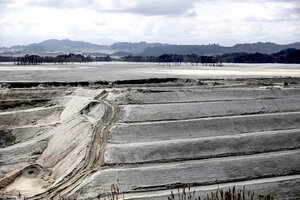An open door on the world’s ore
As demand for green metals soars, the mining industry sets higher standards of transparency for itself. The reforms may help better tackle climate change.

A view of Cobre Panama mine of Canadian First Quantum Minerals, one of the world's largest open-pit copper mines, which was forced to shut down after Panama's top court ruled that its contract was unconstitutional following nationwide protests opposed to its continued operation.
REUTERS
The world’s transition to green energy poses an inconvenient conundrum: how to avert one environmental crisis without creating another. To fuel that shift, mining for the ores needed in renewable technologies is set to expand rapidly over the next quarter century – by as much as 50% for uranium and 500% for lithium, according to various estimates.
Much of the current activity is happening in the absence of reliable data. A study published by Nature this month found that more than half (56%) of mining areas visible by satellite have no known reported production information. That makes enabling the needed growth while also mitigating the impact of extraction more difficult.
Some in the industry are now aiming to correct that. The International Council on Mining and Minerals, a trade group representing more than 60 of the world’s largest mining companies and mining associations, adopted what it hailed as a groundbreaking commitment to protect nature and communities near mines. Members promised to disclose the environmental risks of all projects by 2026 and ensure they cause no net loss of biodiversity by 2030.
Industrial greenwashing? Time will tell. But the council’s new rules neatly frame the start of a year in which transparency will become a critical tool in addressing climate change. By December, all 195 signatories to the 2015 Paris Agreement must submit their first biennial transparency reports measuring their progress toward meeting the shared goals of the climate accord.
That coincides with efforts by a growing number of governments to strengthen the accountability of mining companies through data transparency and engagement with local communities – particularly Indigenous peoples – whose lands abut their worksites. In a workshop on transparency at the United Nations climate conference in Dubai, United Arab Emirates, last month, experts asked participants to describe what the term meant to them in practice. Responses included “common understanding,” “empowering communities,” and “building trust.”
To accelerate solutions to climate change, “transparency issues must be resolved,” notes Christopher Martius, an energy expert at the Center for International Forestry Research in Bogor, Indonesia. “Better data coherence can increase trust and accountability, as can improved participation and access to data,” he argued at the Dubai gathering.
On another front, the mining industry faces many anti-corruption investigations. The Organization for Economic Cooperation and Development estimates that 1 in 5 foreign bribes involve an extractive project. Now the industry faces demands for higher standards of environmental care. Its new rules are an acknowledgment that, more than ever, permits to dig deep depend on cultivating higher ideals.

